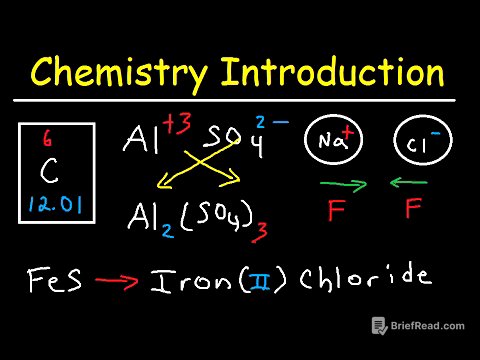TLDR;
This video explains condensation and hydrolysis, two fundamental chemical processes involving water in the formation and breakdown of biomolecules. It also discusses the unique properties of water, such as its polar nature, cohesive and adhesive forces, high specific heat, high heat of vaporization, expansion at low temperatures, and ionization, highlighting their importance for life.
- Condensation involves the removal of water to form larger molecules, while hydrolysis involves the addition of water to break down larger molecules.
- Water's polarity leads to hydrogen bonding, which gives it unique properties like high specific heat and acting as a universal solvent.
- These properties of water are essential for maintaining cellular structures, facilitating transport, stabilizing temperature, and supporting aquatic life.
Condensation and Hydrolysis [0:00]
Condensation is the process where micromolecules or monomers combine to form polymers or macromolecules, such as glucose molecules forming starch or amino acids forming proteins. Hydrolysis is the reverse process, where polymers break down into monomers. Both processes involve water; condensation removes water (H2O) as hydrogen and hydroxyl groups react and form a bond between molecules, while hydrolysis adds water to break the bond. Dehydration synthesis is a specific type of condensation where water is removed during the formation of biomolecules.
Water as the Medium of Life [3:15]
Water is essential as the medium of life, constituting a significant portion of protoplasm (inside cells) and the extracellular environment (e.g., interstitial fluid). The water content in cells is crucial for their survival; a significant reduction can lead to cell death. Water's unique properties make it indispensable for life processes.
Polar Nature of Water [5:01]
Water's polar nature arises from the difference in electronegativity between hydrogen and oxygen, resulting in partial negative and positive charges on the molecule. This polarity leads to intermolecular attractive forces known as hydrogen bonds. Hydrogen bonds give water a high melting and boiling point, allowing it to remain liquid at temperatures suitable for life.
Universal Solvent [7:43]
Water's polarity enables it to dissolve polar molecules, ionic compounds, minerals, charged molecules, and gases, making it a universal solvent. This property is crucial for metabolism, as dissolved molecules can participate in metabolic reactions. However, water cannot dissolve non-polar materials like lipids, which is essential for maintaining cellular structures through hydrophobic exclusion.
Cohesive and Adhesive Forces [11:38]
Water exhibits both cohesive and adhesive forces. Cohesive force, due to hydrogen bonding, is the attraction between water molecules. Adhesive force is the attraction between water molecules and the walls of a container, resulting from electrostatic forces. These forces enable water to move freely in small vessels, acting as a transport medium in blood and xylem.
High Specific Heat [16:27]
Water has a high specific heat or heat capacity, meaning it requires a significant amount of heat to raise its temperature. This property is due to hydrogen bonding, which necessitates more energy to increase the kinetic energy of water molecules. As a result, water acts as a temperature stabilizer in living organisms, preventing rapid changes in body temperature.
High Heat of Vaporization [19:36]
Water's high heat of vaporization means a large amount of heat is required to evaporate it. This property facilitates cooling through evaporation, such as sweating in animals and transpiration in plants. Evaporation removes heat from the body or plant, providing a cooling effect.
Water Expands at Low Temperatures [21:32]
Water expands at low temperatures. Water is most dense at 4°C, where molecules are closest together. Below 4°C, hydrogen bonding increases, forming a hexagonal crystal lattice in ice, which increases the space between molecules. This expansion causes ice to be less dense than liquid water, allowing it to float on the surface.
Benefits of Ice Floating on Water [24:57]
The fact that ice floats on water is beneficial for aquatic life. In cold environments, ice forms on the surface of water bodies, insulating the water below and allowing aquatic organisms to survive.
Ionization of Water [25:54]
Water undergoes ionization, forming hydrogen and hydroxide ions. Pure water is a poor conductor of electricity due to low ionization. However, the ionization property of water allows it to maintain pH levels in various biological systems, such as lysosomes and the cytosol, which is crucial for enzyme function and overall cellular health.









